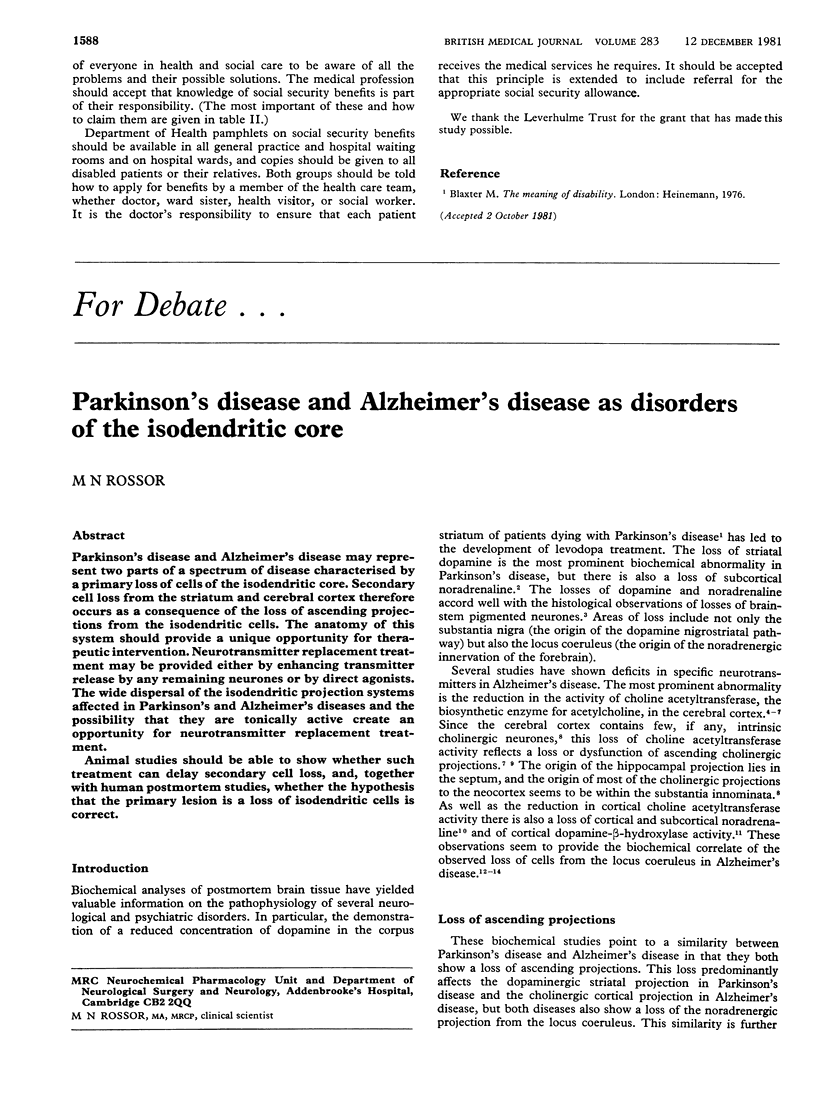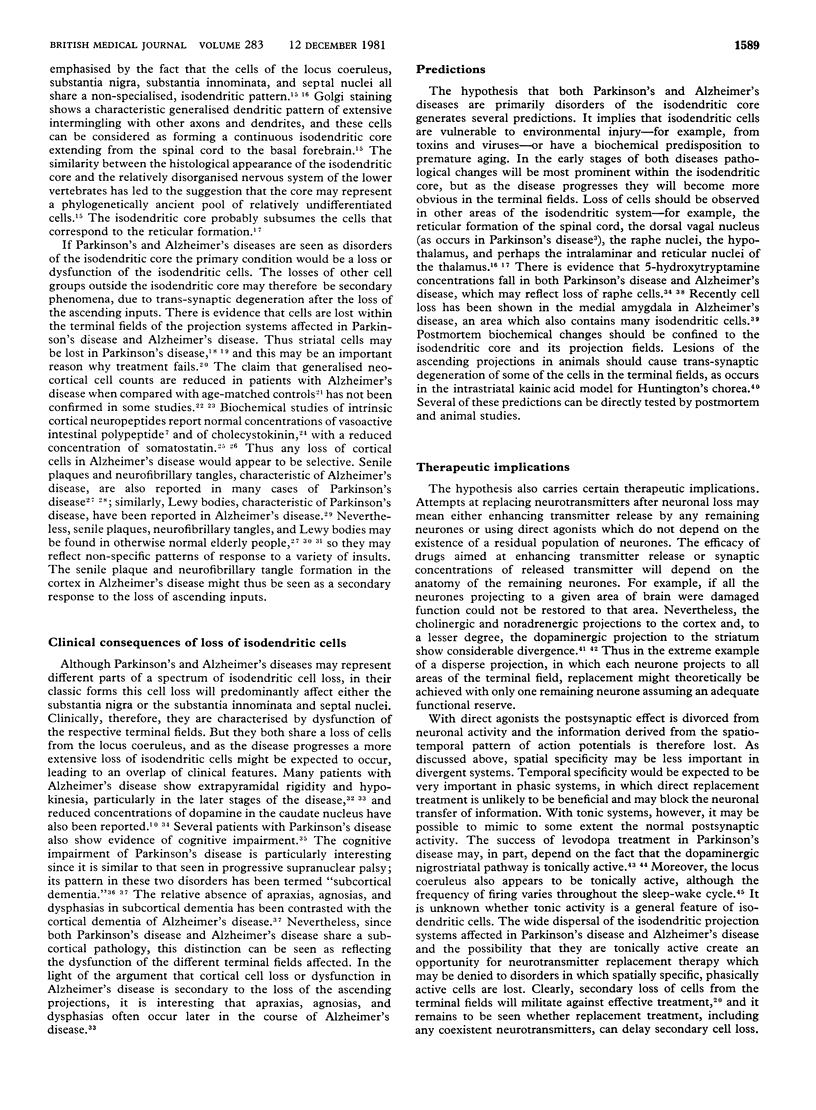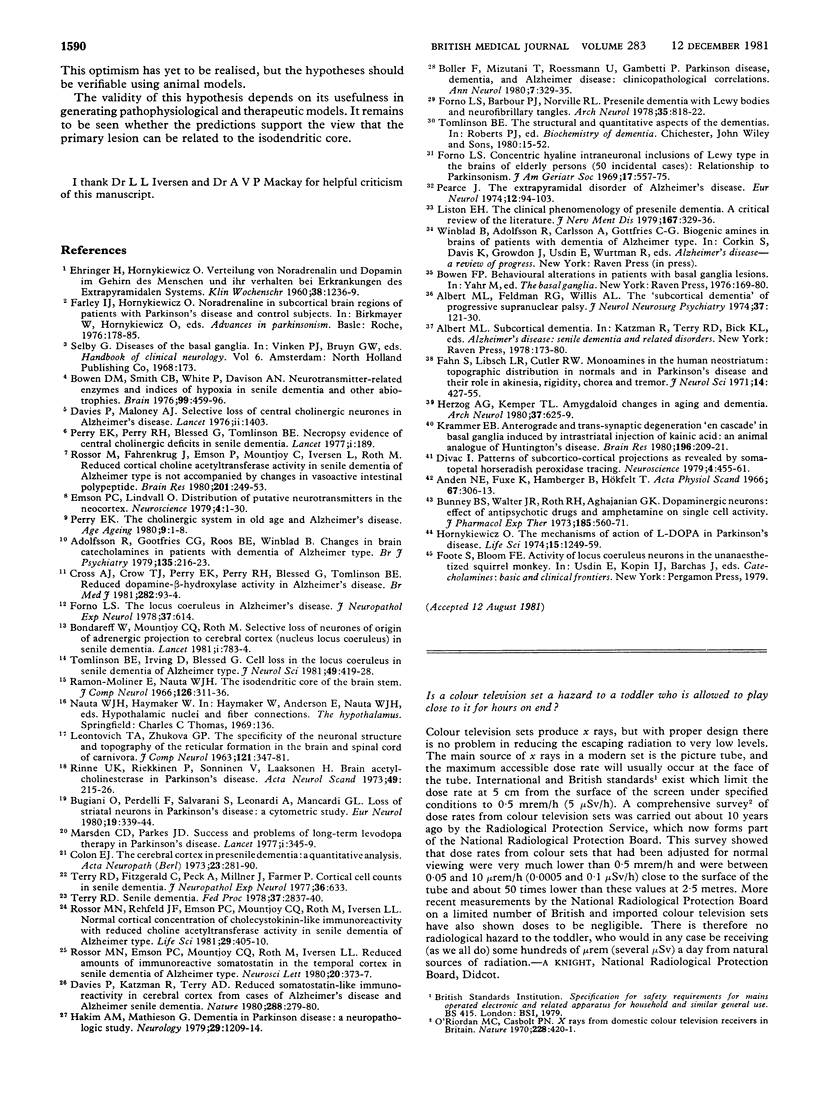Abstract
Parkinson's disease and Alzheimer's disease may represent two parts of a spectrum of disease characterised by a primary loss of cells of the isodendritic core. Secondary cell loss from the striatum and cerebral cortex therefore occurs as a consequence of the loss of ascending projections from the isodendritic cells. The anatomy of this system should provide a unique opportunity for therapeutic intervention. Neurotransmitter replacement treatment may be provided either by enhancing transmitter release by any remaining neurones or by direct agonists. The wide dispersal of the isodendritic projection systems affected in Parkinson's and Alzheimer's disease and the possibility that they are tonically active create an opportunity for neurotransmitter replacement treatment. Animal studies should be able to show whether such treatment can delay secondary cell loss, and, together with human postmortem studies, whether the hypothesis that the primary lesion is a loss of isodendritic cells is correct.
Full text
PDF


Selected References
These references are in PubMed. This may not be the complete list of references from this article.
- Adolfsson R., Gottfries C. G., Roos B. E., Winblad B. Changes in the brain catecholamines in patients with dementia of Alzheimer type. Br J Psychiatry. 1979 Sep;135:216–223. doi: 10.1192/bjp.135.3.216. [DOI] [PubMed] [Google Scholar]
- Albert M. L., Feldman R. G., Willis A. L. The 'subcortical dementia' of progressive supranuclear palsy. J Neurol Neurosurg Psychiatry. 1974 Feb;37(2):121–130. doi: 10.1136/jnnp.37.2.121. [DOI] [PMC free article] [PubMed] [Google Scholar]
- Andén N. E., Hfuxe K., Hamberger B., Hökfelt T. A quantitative study on the nigro-neostriatal dopamine neuron system in the rat. Acta Physiol Scand. 1966 Jul-Aug;67(3):306–312. doi: 10.1111/j.1748-1716.1966.tb03317.x. [DOI] [PubMed] [Google Scholar]
- Boller F., Mizutani T., Roessmann U., Gambetti P. Parkinson disease, dementia, and Alzheimer disease: clinicopathological correlations. Ann Neurol. 1980 Apr;7(4):329–335. doi: 10.1002/ana.410070408. [DOI] [PubMed] [Google Scholar]
- Bondareff W., Mountjoy C. Q., Roth M. Selective loss of neurones of origin of adrenergic projection to cerebral cortex (nucleus locus coeruleus) in senile dementia. Lancet. 1981 Apr 4;1(8223):783–784. doi: 10.1016/s0140-6736(81)92657-x. [DOI] [PubMed] [Google Scholar]
- Bowen D. M., Smith C. B., White P., Davison A. N. Neurotransmitter-related enzymes and indices of hypoxia in senile dementia and other abiotrophies. Brain. 1976 Sep;99(3):459–496. doi: 10.1093/brain/99.3.459. [DOI] [PubMed] [Google Scholar]
- Bowen F. P. Behavioral alterations in patients with basal ganglia lesions. Res Publ Assoc Res Nerv Ment Dis. 1976;55:169–180. [PubMed] [Google Scholar]
- Bugiani O., Perdelli F., Salvarani S., Leonardi A., Mancardi G. L. Loss of striatal neurons in Parkinson's disease: a cytometric study. Eur Neurol. 1980;19(5):339–344. doi: 10.1159/000115172. [DOI] [PubMed] [Google Scholar]
- Bunney B. S., Walters J. R., Roth R. H., Aghajanian G. K. Dopaminergic neurons: effect of antipsychotic drugs and amphetamine on single cell activity. J Pharmacol Exp Ther. 1973 Jun;185(3):560–571. [PubMed] [Google Scholar]
- Colon E. J. The cerebral cortex in presenile dementia. A quantitative analysis. Acta Neuropathol. 1973;23(4):281–290. doi: 10.1007/BF00687457. [DOI] [PubMed] [Google Scholar]
- Davies P., Katzman R., Terry R. D. Reduced somatostatin-like immunoreactivity in cerebral cortex from cases of Alzheimer disease and Alzheimer senile dementa. Nature. 1980 Nov 20;288(5788):279–280. doi: 10.1038/288279a0. [DOI] [PubMed] [Google Scholar]
- Davies P., Maloney A. J. Selective loss of central cholinergic neurons in Alzheimer's disease. Lancet. 1976 Dec 25;2(8000):1403–1403. doi: 10.1016/s0140-6736(76)91936-x. [DOI] [PubMed] [Google Scholar]
- Divac I. Patterns of subcortico-cortical projections as revealed by somatopetal horseradish peroxidase tracing. Neuroscience. 1979;4(4):455–461. doi: 10.1016/0306-4522(79)90123-4. [DOI] [PubMed] [Google Scholar]
- EHRINGER H., HORNYKIEWICZ O. [Distribution of noradrenaline and dopamine (3-hydroxytyramine) in the human brain and their behavior in diseases of the extrapyramidal system]. Klin Wochenschr. 1960 Dec 15;38:1236–1239. doi: 10.1007/BF01485901. [DOI] [PubMed] [Google Scholar]
- Emson P. C., Lindvall O. Distribution of putative neurotransmitters in the neocortex. Neuroscience. 1979;4(1):1–30. doi: 10.1016/0306-4522(79)90215-x. [DOI] [PubMed] [Google Scholar]
- Fahn S., Libsch L. R., Cutler R. W. Monoamines in the human neostriatum: topographic distribution in normals and in Parkinson's disease and their role in akinesia, rigidity, chorea, and tremor. J Neurol Sci. 1971 Dec;14(4):427–455. doi: 10.1016/0022-510x(71)90178-x. [DOI] [PubMed] [Google Scholar]
- Forno L. S., Barbour P. J., Norville R. L. Presenile dementia with Lewy bodies and neurofibrillary tangles. Arch Neurol. 1978 Dec;35(12):818–822. doi: 10.1001/archneur.1978.00500360042008. [DOI] [PubMed] [Google Scholar]
- Forno L. S. Concentric hyalin intraneuronal inclusions of Lewy type in the brains of elderly persons (50 incidental cases): relationship to parkinsonism. J Am Geriatr Soc. 1969 Jun;17(6):557–575. doi: 10.1111/j.1532-5415.1969.tb01316.x. [DOI] [PubMed] [Google Scholar]
- Hakim A. M., Mathieson G. Dementia in Parkinson disease: a neuropathologic study. Neurology. 1979 Sep;29(9 Pt 1):1209–1214. doi: 10.1212/wnl.29.9_part_1.1209. [DOI] [PubMed] [Google Scholar]
- Herzog A. G., Kemper T. L. Amygdaloid changes in aging and dementia. Arch Neurol. 1980 Oct;37(10):625–629. doi: 10.1001/archneur.1980.00500590049006. [DOI] [PubMed] [Google Scholar]
- Hornykiewicz O. The mechanisms of action of L-dopa in Parkinson's disease. Life Sci. 1974 Oct 1;15(7):1249–1259. doi: 10.1016/0024-3205(74)90306-3. [DOI] [PubMed] [Google Scholar]
- Krammer E. B. Anterograde and transsynaptic degeneration 'en cascade' in basal ganglia induced by intrastriatal injection of kainic acid: an animal analogue of Huntington's disease. Brain Res. 1980 Aug 25;196(1):209–221. doi: 10.1016/0006-8993(80)90727-1. [DOI] [PubMed] [Google Scholar]
- LEONTOVICH T. A., ZHUKOVA G. P. THE SPECIFICITY OF THE NEURONAL STRUCTURE AND TOPOGRAPHY OF THE RETICULAR FORMATION IN THE BRAIN AND SPINAL CORD OF CARNIVORA. J Comp Neurol. 1963 Dec;121:347–379. doi: 10.1002/cne.901210305. [DOI] [PubMed] [Google Scholar]
- Liston E. H. The clinical phenomenology of presenile dementia. A critical review of the literature. J Nerv Ment Dis. 1979 Jun;167(6):329–336. doi: 10.1097/00005053-197906000-00001. [DOI] [PubMed] [Google Scholar]
- Marsden C. D., Parkes J. D. Success and problems of long-term levodopa therapy in Parkinson's disease. Lancet. 1977 Feb 12;1(8007):345–349. doi: 10.1016/s0140-6736(77)91146-1. [DOI] [PubMed] [Google Scholar]
- O'Riordan M. C., Casbolt P. N. X-rays from domestic colour television receivers in Britain. Nature. 1970 Oct 31;228(5270):420–421. doi: 10.1038/228420a0. [DOI] [PubMed] [Google Scholar]
- Pearce J. The extrapyramidal disorder of Alzheimer's disease. Eur Neurol. 1974;12(2):94–103. doi: 10.1159/000114608. [DOI] [PubMed] [Google Scholar]
- Perry E. K., Perry R. H., Blessed G., Tomlinson B. E. Necropsy evidence of central cholinergic deficits in senile dementia. Lancet. 1977 Jan 22;1(8004):189–189. doi: 10.1016/s0140-6736(77)91780-9. [DOI] [PubMed] [Google Scholar]
- Perry E. K. The cholinergic system in old age and Alzheimer's disease. Age Ageing. 1980 Feb;9(1):1–8. doi: 10.1093/ageing/9.1.1. [DOI] [PubMed] [Google Scholar]
- Ramón-Moliner E., Nauta W. J. The isodendritic core of the brain stem. J Comp Neurol. 1966 Mar;126(3):311–335. doi: 10.1002/cne.901260301. [DOI] [PubMed] [Google Scholar]
- Rinne U. K., Riekkinen P., Sonninen V., Laaksonen H. Brain acetylcholinesterase in Parkinson's disease. Acta Neurol Scand. 1973;49(2):215–226. doi: 10.1111/j.1600-0404.1973.tb01293.x. [DOI] [PubMed] [Google Scholar]
- Rossor M. N., Emson P. C., Mountjoy C. Q., Roth M., Iversen L. L. Reduced amounts of immunoreactive somatostatin in the temporal cortex in senile dementia of Alzheimer type. Neurosci Lett. 1980 Dec;20(3):373–377. doi: 10.1016/0304-3940(80)90177-9. [DOI] [PubMed] [Google Scholar]
- Rossor M. N., Rehfeld J. F., Emson P. C., Mountjoy C. Q., Roth M., Iversen L. L. Normal cortical concentration of cholecystokinin-like immunoreactivity with reduced choline acetyltransferase activity in senile dementia of Alzheimer type. Life Sci. 1981 Jul 27;29(4):405–410. doi: 10.1016/0024-3205(81)90334-9. [DOI] [PubMed] [Google Scholar]
- Rossor M., Fahrenkrug J., Emson P., Mountjoy C., Iversen L., Roth M. Reduced cortical choline acetyltransferase activity in senile dementia of Alzheimer type is not accompanied by changes in vasoactive intestinal polypeptide. Brain Res. 1980 Nov 10;201(1):249–253. doi: 10.1016/0006-8993(80)90795-7. [DOI] [PubMed] [Google Scholar]
- Terry R. D. Senile dementia. Fed Proc. 1978 Dec;37(14):2837–2840. [PubMed] [Google Scholar]
- Tomlinson B. E., Irving D., Blessed G. Cell loss in the locus coeruleus in senile dementia of Alzheimer type. J Neurol Sci. 1981 Mar;49(3):419–428. doi: 10.1016/0022-510x(81)90031-9. [DOI] [PubMed] [Google Scholar]


